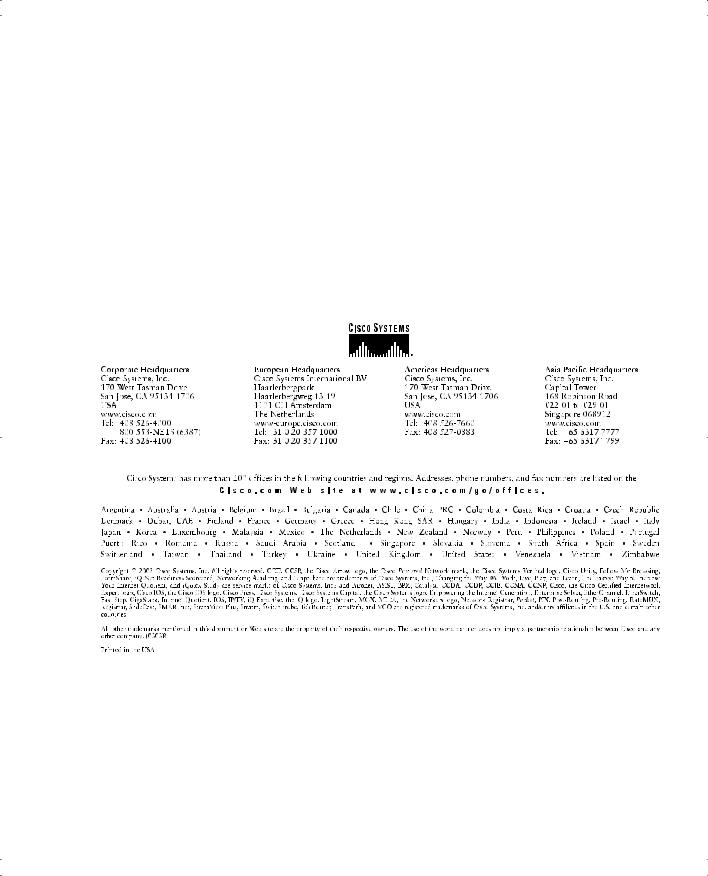
- •Warning and Disclaimer
- •Feedback Information
- •Trademark Acknowledgments
- •About the Author
- •About the Technical Reviewers
- •Dedication
- •Acknowledgments
- •Contents at a Glance
- •Contents
- •Icons Used in This Book
- •Command Syntax Conventions
- •Cisco’s Motivation: Certifying Partners
- •Format of the CCNA Exams
- •What’s on the CCNA Exams
- •ICND Exam Topics
- •Cross-Reference Between Exam Topics and Book Parts
- •CCNA Exam Topics
- •INTRO and ICND Course Outlines
- •Objectives and Methods
- •Book Features
- •How This Book Is Organized
- •Part I: LAN Switching
- •Part II: TCP/IP
- •Part III: Wide-Area Networks
- •Part IV: Network Security
- •Part V: Final Preparation
- •Part VI: Appendixes
- •How to Use These Books to Prepare for the CCNA Exam
- •For More Information
- •Part I: LAN Switching
- •“Do I Know This Already?” Quiz
- •Foundation Topics
- •Brief Review of LAN Switching
- •The Forward-Versus-Filter Decision
- •How Switches Learn MAC Addresses
- •Forwarding Unknown Unicasts and Broadcasts
- •LAN Switch Logic Summary
- •Basic Switch Operation
- •Foundation Summary
- •Spanning Tree Protocol
- •“Do I Know This Already?” Quiz
- •Foundation Topics
- •Spanning Tree Protocol
- •What IEEE 802.1d Spanning Tree Does
- •How Spanning Tree Works
- •Electing the Root and Discovering Root Ports and Designated Ports
- •Reacting to Changes in the Network
- •Spanning Tree Protocol Summary
- •Optional STP Features
- •EtherChannel
- •PortFast
- •Rapid Spanning Tree (IEEE 802.1w)
- •RSTP Link and Edge Types
- •RSTP Port States
- •RSTP Port Roles
- •RSTP Convergence
- •Edge-Type Behavior and PortFast
- •Link-Type Shared
- •Link-Type Point-to-Point
- •An Example of Speedy RSTP Convergence
- •Basic STP show Commands
- •Changing STP Port Costs and Bridge Priority
- •Foundation Summary
- •Foundation Summary
- •Virtual LANs and Trunking
- •“Do I Know This Already?” Quiz
- •Foundation Topics
- •Review of Virtual LAN Concepts
- •Trunking with ISL and 802.1Q
- •ISL and 802.1Q Compared
- •VLAN Trunking Protocol (VTP)
- •How VTP Works
- •VTP Pruning
- •Foundation Summary
- •Part II: TCP/IP
- •IP Addressing and Subnetting
- •“Do I Know This Already?” Quiz
- •Foundation Topics
- •IP Addressing Review
- •IP Subnetting
- •Analyzing and Interpreting IP Addresses and Subnets
- •Math Operations Used to Answer Subnetting Questions
- •Converting IP Addresses from Decimal to Binary and Back Again
- •The Boolean AND Operation
- •How Many Hosts and How Many Subnets?
- •What Is the Subnet Number, and What Are the IP Addresses in the Subnet?
- •Finding the Subnet Number
- •Finding the Subnet Broadcast Address
- •Finding the Range of Valid IP Addresses in a Subnet
- •Finding the Answers Without Using Binary
- •Easier Math with Easy Masks
- •Which Subnet Masks Meet the Stated Design Requirements?
- •What Are the Other Subnet Numbers?
- •Foundation Summary
- •“Do I Know This Already?” Quiz
- •Foundation Topics
- •Extended ping Command
- •Distance Vector Concepts
- •Distance Vector Loop-Avoidance Features
- •Route Poisoning
- •Split Horizon
- •Split Horizon with Poison Reverse
- •Hold-Down Timer
- •Triggered (Flash) Updates
- •RIP and IGRP
- •IGRP Metrics
- •Examination of RIP and IGRP debug and show Commands
- •Issues When Multiple Routes to the Same Subnet Exist
- •Administrative Distance
- •Foundation Summary
- •“Do I Know This Already?” Quiz
- •Foundation Topics
- •Link-State Routing Protocol and OSPF Concepts
- •Steady-State Operation
- •Loop Avoidance
- •Scaling OSPF Through Hierarchical Design
- •OSPF Areas
- •Stub Areas
- •Summary: Comparing Link-State and OSPF to Distance Vector Protocols
- •Balanced Hybrid Routing Protocol and EIGRP Concepts
- •EIGRP Loop Avoidance
- •EIGRP Summary
- •Foundation Summary
- •“Do I Know This Already?” Quiz
- •Foundation Topics
- •Route Summarization and Variable-Length Subnet Masks
- •Route Summarization Concepts
- •VLSM
- •Route Summarization Strategies
- •Sample “Best” Summary on Seville
- •Sample “Best” Summary on Yosemite
- •Classless Routing Protocols and Classless Routing
- •Classless and Classful Routing Protocols
- •Autosummarization
- •Classful and Classless Routing
- •Default Routes
- •Classless Routing
- •Foundation Summary
- •Advanced TCP/IP Topics
- •“Do I Know This Already?” Quiz
- •Foundation Topics
- •Scaling the IP Address Space for the Internet
- •CIDR
- •Private Addressing
- •Network Address Translation
- •Static NAT
- •Dynamic NAT
- •Overloading NAT with Port Address Translation (PAT)
- •Translating Overlapping Addresses
- •Miscellaneous TCP/IP Topics
- •Internet Control Message Protocol (ICMP)
- •ICMP Echo Request and Echo Reply
- •Destination Unreachable ICMP Message
- •Time Exceeded ICMP Message
- •Redirect ICMP Message
- •Secondary IP Addressing
- •FTP and TFTP
- •TFTP
- •MTU and Fragmentation
- •Foundation Summary
- •Part III: Wide-Area Networks
- •“Do I Know This Already?” Quiz
- •Foundation Topics
- •Review of WAN Basics
- •Physical Components of Point-to-Point Leased Lines
- •Data-Link Protocols for Point-to-Point Leased Lines
- •HDLC and PPP Compared
- •Looped Link Detection
- •Enhanced Error Detection
- •Authentication Over WAN Links
- •PAP and CHAP Authentication
- •Foundation Summary
- •“Do I Know This Already?” Quiz
- •Foundation Topics
- •ISDN Protocols and Design
- •Typical Uses of ISDN
- •ISDN Channels
- •ISDN Protocols
- •ISDN BRI Function Groups and Reference Points
- •ISDN PRI Function Groups and Reference Points
- •BRI and PRI Encoding and Framing
- •PRI Encoding
- •PRI Framing
- •BRI Framing and Encoding
- •DDR Step 1: Routing Packets Out the Interface to Be Dialed
- •DDR Step 2: Determining the Subset of the Packets That Trigger the Dialing Process
- •DDR Step 3: Dialing (Signaling)
- •DDR Step 4: Determining When the Connection Is Terminated
- •ISDN and DDR show and debug Commands
- •Multilink PPP
- •Foundation Summary
- •Frame Relay
- •“Do I Know This Already?” Quiz
- •Foundation Topics
- •Frame Relay Protocols
- •Frame Relay Standards
- •Virtual Circuits
- •LMI and Encapsulation Types
- •DLCI Addressing Details
- •Network Layer Concerns with Frame Relay
- •Layer 3 Addressing with Frame Relay
- •Frame Relay Layer 3 Addressing: One Subnet Containing All Frame Relay DTEs
- •Frame Relay Layer 3 Addressing: One Subnet Per VC
- •Frame Relay Layer 3 Addressing: Hybrid Approach
- •Broadcast Handling
- •Frame Relay Service Interworking
- •A Fully-Meshed Network with One IP Subnet
- •Frame Relay Address Mapping
- •A Partially-Meshed Network with One IP Subnet Per VC
- •A Partially-Meshed Network with Some Fully-Meshed Parts
- •Foundation Summary
- •Part IV: Network Security
- •IP Access Control List Security
- •“Do I Know This Already?” Quiz
- •Foundation Topics
- •Standard IP Access Control Lists
- •IP Standard ACL Concepts
- •Wildcard Masks
- •Standard IP ACL: Example 2
- •Extended IP Access Control Lists
- •Extended IP ACL Concepts
- •Extended IP Access Lists: Example 1
- •Extended IP Access Lists: Example 2
- •Miscellaneous ACL Topics
- •Named IP Access Lists
- •Controlling Telnet Access with ACLs
- •ACL Implementation Considerations
- •Foundation Summary
- •Part V: Final Preparation
- •Final Preparation
- •Suggestions for Final Preparation
- •Preparing for the Exam Experience
- •Final Lab Scenarios
- •Scenario 1
- •Scenario 1, Part A: Planning
- •Solutions to Scenario 1, Part A: Planning
- •Scenario 2
- •Scenario 2, Part A: Planning
- •Solutions to Scenario 2, Part A: Planning
- •Part VI: Appendixes
- •Glossary
- •Answers to the “Do I Know This Already?” Quizzes and Q&A Questions
- •Chapter 1
- •“Do I Know This Already?” Quiz
- •Chapter 2
- •“Do I Know This Already?” Quiz
- •Chapter 3
- •“Do I Know This Already?” Quiz
- •Chapter 4
- •“Do I Know This Already?” Quiz
- •Chapter 5
- •“Do I Know This Already?” Quiz
- •Chapter 6
- •“Do I Know This Already?” Quiz
- •Chapter 7
- •“Do I Know This Already?” Quiz
- •Chapter 8
- •“Do I Know This Already?” Quiz
- •Chapter 9
- •“Do I Know This Already?” Quiz
- •Chapter 10
- •“Do I Know This Already?” Quiz
- •Chapter 11
- •“Do I Know This Already?” Quiz
- •Chapter 12
- •“Do I Know This Already?” Quiz
- •Using the Simulation Software for the Hands-on Exercises
- •Accessing NetSim from the CD
- •Hands-on Exercises Available with NetSim
- •Scenarios
- •Labs
- •Listing of the Hands-on Exercises
- •How You Should Proceed with NetSim
- •Considerations When Using NetSim
- •Routing Protocol Overview
- •Comparing and Contrasting IP Routing Protocols
- •Routing Through the Internet with the Border Gateway Protocol
- •RIP Version 2
- •The Integrated IS-IS Link State Routing Protocol
- •Summary of Interior Routing Protocols
- •Numbering Ports (Interfaces)

CCNA Self-Study
CCNA ICND
Exam Certification Guide
Wendell Odom, CCIE No.1624
Cisco Press
Cisco Press
201 West 103rd Street
Indianapolis, IN 46290 USA

ii
CCNA ICND Exam Certification Guide
Wendell Odom
Copyright© 2004 Cisco Systems, Inc.
Published by: Cisco Press
201 West 103rd Street Indianapolis, IN 46290 USA
All rights reserved. No part of this book may be reproduced or transmitted in any form or by any means, electronic or mechanical, including photocopying and recording, or by any information storage and retrieval system, without written permission from the publisher, except for the inclusion of brief quotations in a review.
Printed in the United States of America 1 2 3 4 5 6 7 8 9 0
First Printing July 2003
Library of Congress Cataloging-in-Publication Number: 2002116060
ISBN: 1-58720-083-x
Warning and Disclaimer
This book is designed to provide information about selected topics for the ICND Exam for the CCNA certification. Every effort has been made to make this book as complete and accurate as possible, but no warranty or fitness is implied.
The information is provided on an “as is” basis. The author, Cisco Press, and Cisco Systems, Inc. shall have neither liability nor responsibility to any person or entity with respect to any loss or damages arising from the information contained in this book or from the use of the discs or programs that may accompany it.
The opinions expressed in this book belong to the author and are not necessarily those of Cisco Systems, Inc.
Feedback Information
At Cisco Press, our goal is to create in-depth technical books of the highest quality and value. Each book is crafted with care and precision, undergoing rigorous development that involves the unique expertise of members of the professional technical community.
Reader feedback is a natural continuation of this process. If you have any comments regarding how we could improve the quality of this book, or otherwise alter it to better suit your needs, you can contact us through e-mail at feedback@ciscopress.com. Please be sure to include the book’s title and ISBN in your message.
We greatly appreciate your assistance.
Trademark Acknowledgments
All terms mentioned in this book that are known to be trademarks or service marks have been appropriately capitalized. Cisco Press or Cisco Systems, Inc. cannot attest to the accuracy of this information. Use of a term in this book should not be regarded as affecting the validity of any trademark or service mark.

iii
Publisher: John Wait |
Cisco Representative: Anthony Wolfenden |
Editor-In-Chief: John Kane |
Cisco Press Program Manager: Sonia Torres Chavez |
Executive Editor: Brett Bartow |
Cisco Marketing Communications Manager: Scott Miller |
Managing Editor: Patrick Kanouse |
Cisco Marketing Program Manager: Edie Quiroz |
Development Editor: Christopher Cleveland |
Technical Editors: Elan Beer, Lynn Maynes, Martin Walshaw |
Project Editor: Marc Fowler |
|
Copy Editor: Gayle Johnson |
|
Team Coordinator: Tammi Barnett |
|
Book Designer: Louisa Adair |
|
Cover Designer: Louisa Adair |
|
Compositor: Mark Shirar |
|
Indexer: Tim Wright |
|

iv
About the Author
Wendell Odom, CCIE No.1624, is a senior instructor with Skyline Computer (www.skylinecomputer.com), where he teaches courses on QoS, CCNA, and CCIE lab preparation. He has worked in the networking arena for 20 years, with jobs in preand postsales technical consulting, teaching, and course development. He has written portions of more than 12 courses, covering topics such as IP routing, MPLS, Cisco WAN switches, SNA protocols, and LAN troubleshooting. He is the author of three prior editions of CCNA Exam Certification Guide and DQOS Exam Certification Guide.
About the Technical Reviewers
Elan Beer, CCIE No. 1837, CCSI No. 94008, is a senior consultant and Certified Cisco Instructor. His internetworking expertise is recognized internationally through his global consulting and training engagements. As one of the industry’s top internetworking consultants and Cisco instructors, Beer has used his expertise to design, implement, and deploy multi-protocol networks for a wide international clientele. As a senior instructor and course developer, Beer has designed and presented public and implementation-specific technical courses spanning many of today’s top technologies. He can be reached at elan@CiscoConsultants.com.
Lynn Maynes, CCIE No. 6569, is a senior network engineer with Sprint Managed Network Services specializing in network design, architecture, and security for large-scale networks worldwide. He has more than 9 years of experience in computer networking and is a coauthor of the Cisco Press book, CCNA Practical Studies. He holds a bachelor’s degree in international business from Westminster College.
Martin Walshaw, CCIE No. 5629, CISSP, CCNP, CCDP, is a systems engineer working for Cisco Systems in the Enterprise line of business in South Africa. His areas of specialty include convergence, security, and content delivery networking. Over the last 15 years, Walshaw has dabbled in many aspects of the IT industry, ranging from programming in RPG III and COBOL to PC sales. When Walshaw isn’t working, he likes to spend all his available time with his patient wife, Val, and his sons, Joshua and Callum. Without their patience, understanding, and support, projects such as this would not be possible.
Dedication
The nature of the book-writing process requires some long and odd work hours. My darling wife, Kris, never complains about it, picks up my slack, and makes our lives run smoothly— all so I can write. Kris, the first time you read this dedication, you’re entitled to a whole week of “Honey do” tasks from me at home. Thanks for making it all possible!

v
Acknowledgments
The technical editing team for this book and its companion volume were fantastic. Not only did they find where I had written wrong technical facts, they also helped me find new, more interesting, and clearer ways to convey certain facts about networking. Lynn was particularly helpful with comments that helped keep small sections in line with the overall theme of the chapter—a skill I’m sure he developed as a result of having written books himself. Martin helped a lot with technical details and perspectives from what customers see every day. And Elan excelled at noticing both small, nitpicky errors and significant technical problems. (And that’s not an insult—every technical author loves help in finding the small problems!) Together, these three gentlemen formed a great team with complementary skills. Thanks so much, guys!
The production team, headed by Patrick Kanouse, did their usual excellent job. Like the “behind-the-scenes” people in many businesses, their specific efforts might not be obvious to the public, but they are no less appreciated by me. In particular, Marc Fowler, the project editor, did an incredible job working through these two books on a very tight schedule, with his usual excellent work. You folks make me look good on paper. If only you could be in charge of my wardrobe too, I’d look good all the time!
Brett Bartow, Executive Editor, did his usual New-York-Yankees-like job of helping steer these two projects toward completion. In between talking about sports, Brett worked through the many changes in direction with this book and helped guide us to the right product. And yes, so the whole world knows, he did pick an Atlanta Braves player, John Smoltz, for his fantasy league baseball team—again proving he’s a really smart guy.
Chris Cleveland developed this book and the CCNA INTRO Exam Certification Guide. He’s simply the best. He also works way harder than I do to get these books to market. You da man, Chris C!
